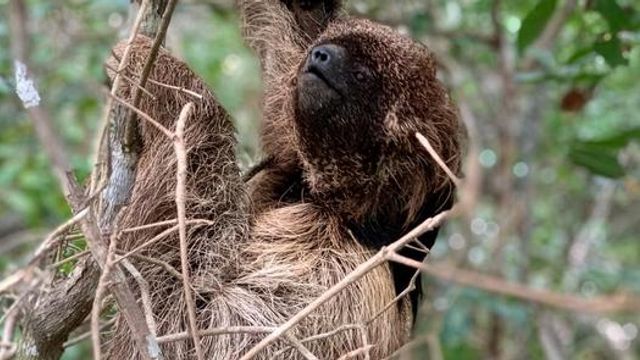Over 13K boats inspected for aquatic invasive species during Pioneer Day weekend – Utah Division of Wildlife Resources (.gov)

Inter-Agency Operations to Mitigate Aquatic Invasive Species in Utah
A multi-agency operation was conducted during the July 24th holiday weekend to prevent the proliferation of aquatic invasive species (AIS). Personnel from the Utah Department of Natural Resources (DNR), Utah Division of Wildlife Resources (DWR), Utah State Parks, Arizona Game and Fish Department, and the National Park Service collaborated on a comprehensive watercraft inspection and decontamination initiative. The primary objective was to safeguard Utah’s waterbodies from the introduction of species such as quagga mussels and Eurasian watermilfoil, primarily from Lake Powell and other infested out-of-state reservoirs.
Alignment with Sustainable Development Goals (SDGs)
This initiative directly supports several United Nations Sustainable Development Goals (SDGs) by protecting vital natural resources and community infrastructure.
SDG 14: Life Below Water & SDG 15: Life on Land
The core mission aligns with the conservation and sustainable use of freshwater ecosystems. By preventing the introduction and spread of invasive alien species (Target 15.8), the program works to halt biodiversity loss (Target 15.5). Invasive species like quagga mussels and Eurasian watermilfoil disrupt local food webs and outcompete native flora and fauna, making their containment essential for protecting life below water (SDG 14) and the health of surrounding terrestrial ecosystems.
SDG 6: Clean Water and Sanitation
The effort is critical for maintaining water quality and ensuring the operational integrity of water infrastructure. Quagga mussels pose a significant threat by clogging water delivery systems, which can compromise access to clean and affordable water (Target 6.1) and sanitation services. Protecting this infrastructure from biofouling prevents costly maintenance and potential increases in utility costs for consumers.
SDG 11: Sustainable Cities and Communities
By safeguarding water delivery and irrigation infrastructure, the AIS program contributes to the resilience and sustainability of communities. Protecting these essential services from disruption by invasive species ensures that cities and human settlements remain safe and functional, preserving both natural heritage and resource efficiency.
Operational Summary and Key Statistics
From Thursday to Monday, the joint task force achieved the following results statewide:
- Total Watercraft Inspected: 13,383
- Total Decontaminations Performed: 260
- Lake Powell Area Inspections: 1,189
- Lake Powell Area Decontaminations: 55
Enforcement and Compliance Issues
DNR officers detected 44 violations of state laws designed to prevent the spread of AIS.
Common Violations
- Failure to Complete the Mandatory Mussel Aware Course
- Failure to Pay the Aquatic Invasive Species Fee
- Failure to Remove Drain Plugs During Transport
Areas of Concern
A primary concern remains the bypassing of Mandatory Watercraft Inspection Stations, with a particular focus on the new station in Kanab. It is a legal requirement for all individuals transporting watercraft in this area to stop for inspection. This mandate applies even to watercraft that have already been inspected at other locations, such as Lake Powell, to ensure verification and containment.
Ecological and Economic Impacts of Aquatic Invasive Species
The threats posed by AIS have significant consequences for ecosystems, infrastructure, and economies, underscoring the importance of preventative measures.
Threat Analysis: Quagga Mussels
- Infrastructure Damage (SDG 6, SDG 11): Mussels clog large-diameter water lines and delivery systems, necessitating millions of dollars in annual removal costs that can lead to higher utility bills. They also foul and damage boat engine cooling systems.
- Ecosystem Disruption (SDG 14, SDG 15): They filter plankton from the water, collapsing the foundation of the aquatic food web and causing harm to native fish species.
- Recreational and Amenity Loss: Large die-offs result in foul odors and beaches littered with sharp shells, degrading the quality of public recreational areas.
Threat Analysis: Eurasian Watermilfoil
- Biodiversity Loss (SDG 14, SDG 15): This invasive plant grows in dense mats that block sunlight, outcompeting and eliminating native aquatic plants essential for fish and wildlife habitats.
- Infrastructure and Economic Impact (SDG 6, SDG 11): It can clog irrigation pipes, disrupting agriculture, and tangle around boat propellers, causing damage. Removal from an infested waterbody is exceptionally expensive.
- High Proliferation Risk: A single plant fragment is capable of starting a new infestation, making transport prevention the most effective control strategy.
State Infrastructure and Public Guidance
Utah has established a robust network of over 40 inspection stations and five specialized dip tanks to facilitate efficient and effective decontamination of complex watercraft. These facilities are strategically located at boat ramps, along highways, and at Port of Entry stations. Boaters and users of nonmotorized watercraft are directed to consult the STD of the Sea website for a complete list of decontamination stations and detailed information on legal requirements.
1. Which SDGs are addressed or connected to the issues highlighted in the article?
The article discusses efforts to prevent the spread of aquatic invasive species in Utah’s waterbodies. This work directly connects to several Sustainable Development Goals (SDGs) focused on protecting ecosystems, biodiversity, and water resources.
- SDG 15: Life on Land – This is the most directly relevant SDG, as its targets include protecting biodiversity and combating invasive alien species in all ecosystems, including freshwater ones.
- SDG 14: Life Below Water – Although often associated with marine environments, this SDG’s principles of conserving and sustainably using aquatic ecosystems are applicable. The article’s focus on protecting lake ecosystems from invasive species that harm native fish and plankton aligns with this goal.
- SDG 6: Clean Water and Sanitation – This SDG is relevant because the invasive species discussed pose a direct threat to water infrastructure. The article notes that quagga mussels can “plug water lines” and “get into water delivery systems,” which would impact water management and costs.
2. What specific targets under those SDGs can be identified based on the article’s content?
Based on the activities and impacts described, several specific SDG targets can be identified:
SDG 15: Life on Land
- Target 15.8: “By 2020, introduce measures to prevent the introduction and significantly reduce the impact of invasive alien species on land and water ecosystems and control or eradicate the priority species.” The entire article is a case study of this target in action. It details measures like mandatory boat inspections, decontamination stations, law enforcement, and public awareness campaigns (“Mussel Aware Course”) specifically designed to prevent the introduction and spread of invasive species like quagga mussels and Eurasian watermilfoil.
- Target 15.5: “Take urgent and significant action to reduce the degradation of natural habitats, halt the loss of biodiversity and, by 2020, protect and prevent the extinction of threatened species.” The article supports this target by explaining how the prevention efforts protect native species. It states that Eurasian watermilfoil “outcompetes native plants, negatively impacting fish and other native aquatic species,” and quagga mussels “remove plankton from the water, which hurts fish species.” The actions taken are urgent measures to halt this biodiversity loss.
SDG 14: Life Below Water
- Target 14.2: “By 2020, sustainably manage and protect marine and coastal ecosystems to avoid significant adverse impacts…” While the context is freshwater, the principle applies directly. The inspection and decontamination program is a clear action to protect lake ecosystems from the “significant adverse impacts” of invasive species, thereby maintaining healthy and productive waterbodies.
SDG 6: Clean Water and Sanitation
- Target 6.6: “By 2020, protect and restore water-related ecosystems, including… lakes.” The efforts of the DWR and its partners are a direct form of protection for Utah’s lake ecosystems, which are explicitly mentioned in this target.
- Target 6.b: “Support and strengthen the participation of local communities in improving water and sanitation management.” The article implies this by mentioning the “Mussel Aware Course” for boaters and the legal requirement for them to stop at inspection stations, highlighting the role and responsibility of the community (boaters) in water protection efforts.
3. Are there any indicators mentioned or implied in the article that can be used to measure progress towards the identified targets?
Yes, the article provides several quantitative and qualitative indicators that can be used to measure the implementation of prevention measures and the enforcement of relevant policies.
Indicators for Target 15.8 (Preventing Invasive Species)
- Number of boat inspections: The article states that “13,383 boats” were inspected over the holiday weekend. This is a direct measure of the scale of prevention activities.
- Number of decontaminations performed: The text specifies “260 decontaminations” were carried out. This indicator measures the direct intervention to eliminate threats.
- Number of violations detected: The article reports “44 violations” were detected by officers. This serves as an indicator of policy enforcement and boater compliance levels.
- Number of prevention infrastructures: The article mentions the existence of “over 40 inspection stations” and “five dip tanks,” which are indicators of the capacity and infrastructure dedicated to achieving the target.
Implied Indicators for Targets 15.5, 14.2, and 6.6 (Ecosystem Protection)
- Rate of new infestations: The primary goal is “to prevent quagga mussels… from spreading to other waterbodies in Utah.” Therefore, a key implied success indicator would be the number of new waterbodies reported as infested per year. A low or zero rate would indicate the program’s effectiveness in protecting ecosystems.
- Economic costs avoided: The article states that removing mussels from water delivery systems would cost “millions of dollars annually.” Avoiding these costs is an implied economic indicator of the program’s success.
4. Table of SDGs, Targets, and Indicators
| SDGs | Targets | Indicators Identified in the Article |
|---|---|---|
| SDG 15: Life on Land | 15.8: Prevent the introduction and reduce the impact of invasive alien species on land and water ecosystems. |
|
| SDG 15: Life on Land | 15.5: Take urgent action to reduce the degradation of natural habitats and halt the loss of biodiversity. |
|
| SDG 14: Life Below Water | 14.2: Sustainably manage and protect marine and coastal ecosystems to avoid significant adverse impacts. |
|
| SDG 6: Clean Water and Sanitation | 6.6: Protect and restore water-related ecosystems, including lakes. |
|
Source: wildlife.utah.gov

What is Your Reaction?
 Like
0
Like
0
 Dislike
0
Dislike
0
 Love
0
Love
0
 Funny
0
Funny
0
 Angry
0
Angry
0
 Sad
0
Sad
0
 Wow
0
Wow
0








































































